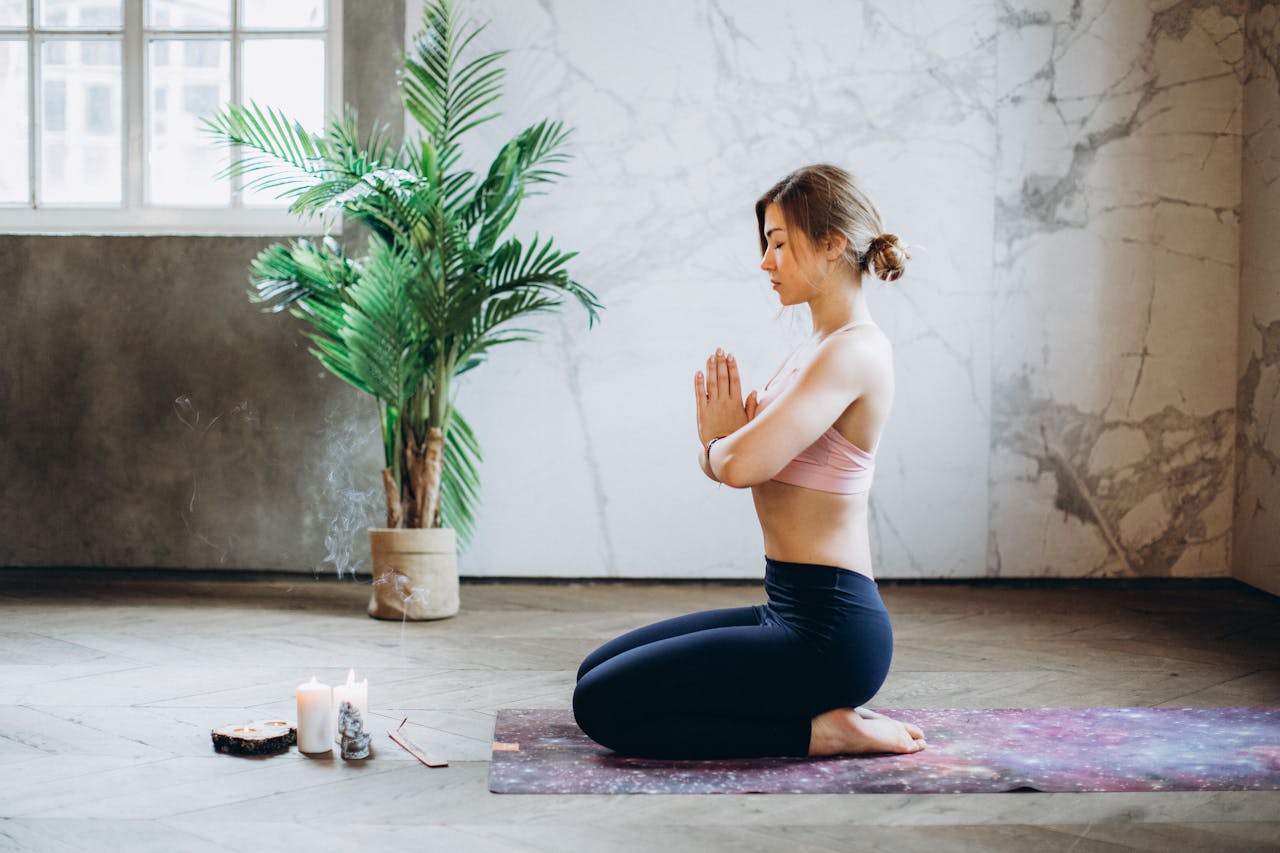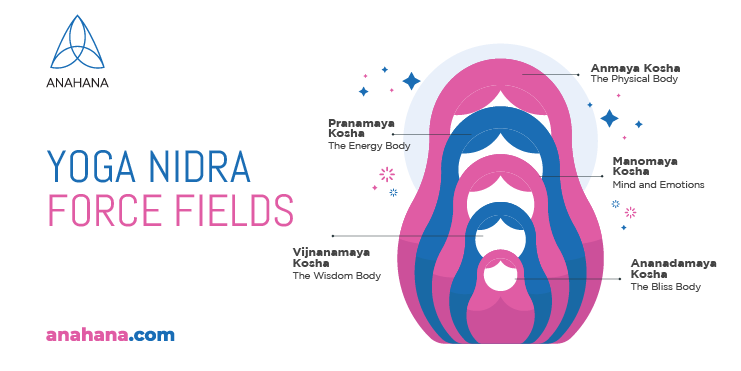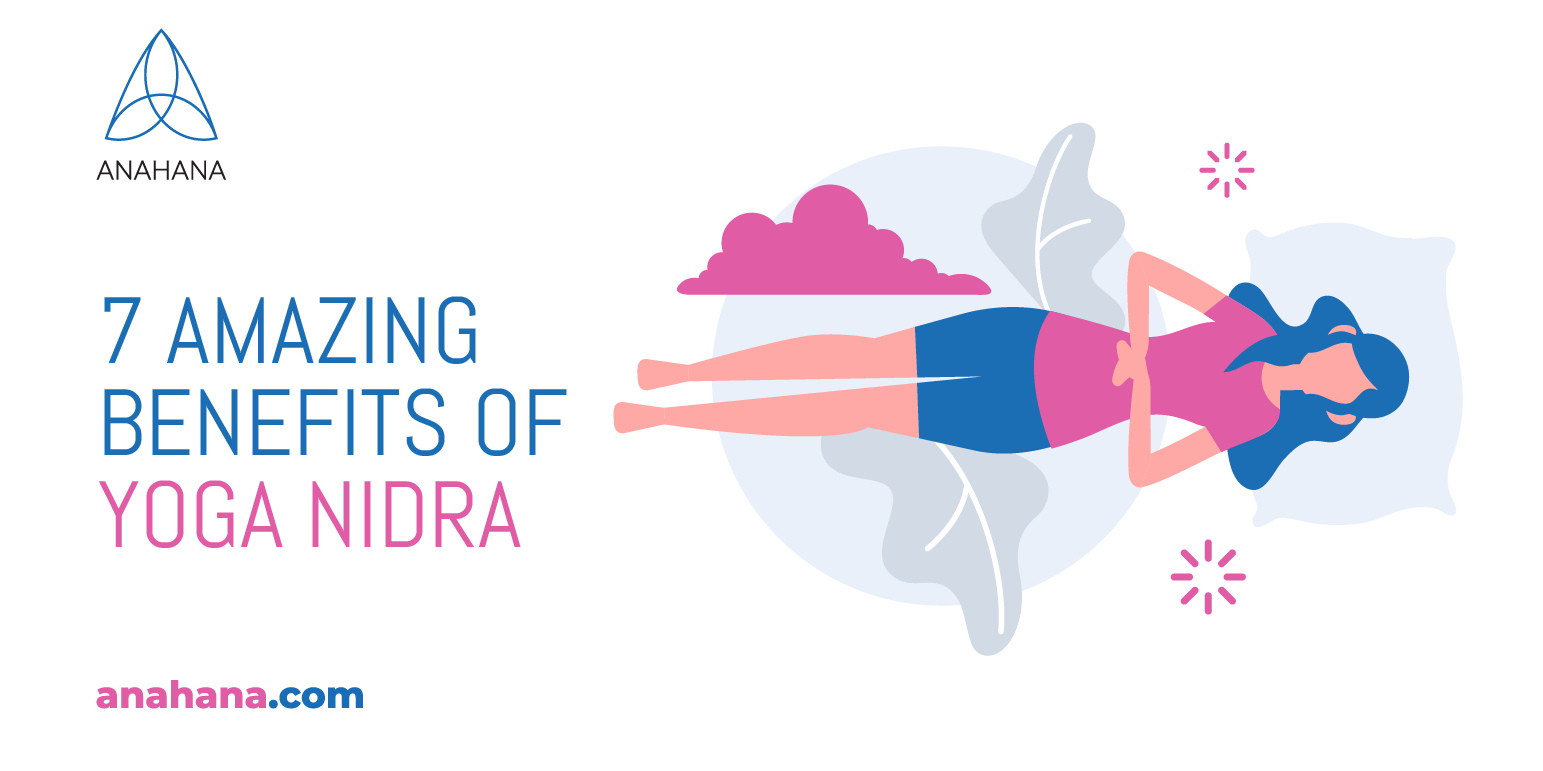
Table of Contents
Yoga Nidra, or yogic sleep, is a practice that is both a meditation practice and a meditative state. It can be thought of as dynamic sleep or sleeping with awareness.
Yoga Nidra works as a systematic process that guides the practitioner to deeper states of consciousness as they observe the different aspects and layers of the mind while resting in a state of deep relaxation. With verbal guidance, the aim is to stay awake while extremely close to the boundary of sleep. This state is achieved by an instructor leading the student into the preliminary sleep stages. The result is an intensely deep level of meditation.
Yoga Nidra and Brain Waves
Body-focusing and breathwork will trigger the relaxation response and a shift out of the fight/flight/freeze states at the start of Yoga Nidra. This stress reduction and physical relaxation cause the brain waves to slow. Alpha, Theta, and Delta brain waves will increase in this stage.
In the next stage, mindfulness and emotional balance will be the focus. Here, alpha brain waves will increase significantly, and the neurotransmitter serotonin will be released more frequently. Additionally, as the practitioner's consciousness changes, there will be an increase in dopamine released; potentially, up to a 65% increase.
The body will continue to go into an even deeper alpha and theta brain wave state also referred to as the REM state.
Finally, the brain will shift to the delta brain-wave state. This is the brain's most restorative state, helping the body achieve the rest it needs. According to researchers at The University of Minnesota, over time and with regular practice, Yoga Nidra practitioners learn to achieve "the deepest, non-REM delta wave sleep while maintaining awareness both internally and of one's surroundings." The delta state activates the parasympathetic nervous systems to reduce anxiety and tension.
Research indicates the Non-Sleep Deep Rest (NSDR) has extensive benefits, including:
-
Improved long term sleep patterns
-
Enhanced physical and mental health
-
Ability to handle challenges with trauma better and addiction
-
Boost overall resilience and emotional balance
History of Yoga Nidra
The Upanishads, ancient Sanskrit texts, are the first writings to mention Yoga Nidra. These texts are from the 7th and 6th centuries and predate both the Common Era and Buddhism.
After studying the Tantric scriptures, Satyananda Saraswati created a Yoga Nidra methodology, which he popularized in the mid-20th century. He explained it as a system that guides one to open the deep layers of the mind. This suggested a link with the ancient tantric practice of Nyasa.
In Nyasa, Sanskrit mantras, sacred sounds or vibrations, are mentally placed within specific body parts, sometimes with physical touch. Meditating on each part of the mind-body in this way is an act of blessing and healing. In the modern-day, some would consider this an esoteric aspect of classical Yoga Nidra, related to the chakras and the energy of the subtle body.
The Koshas
 Yoga Nidra can be thought of as a guided journey through the koshas. The non-dualistic wisdom of yoga philosophy describes the koshas as the five force fields, or subtle sheaths, where the body is the outer sheath radiating from the Atman (essence, Self, or soul).
Yoga Nidra can be thought of as a guided journey through the koshas. The non-dualistic wisdom of yoga philosophy describes the koshas as the five force fields, or subtle sheaths, where the body is the outer sheath radiating from the Atman (essence, Self, or soul).
-
Annamaya Kosha (material sheath and the gross, physical body).
-
Pranayamaya Kosha (energy sheath and vital force or breath).
-
Manomaya Kosha (mental sheath and personality).
-
Vijnanamaya Kosha (intuitive sheath and wisdom).
-
Anandamaya Kosha (blissful sheath).
Evolution And Variations
The following are some of the most well-known lineages and modern teachers of Yoga Nidra:
-
Bihar School of Yoga, founded by Yogi Satyananda Saraswati.
-
Amrit Yoga, founded by Yogi Amrit Desai.
-
Himalayan Institute, Swami Rama.
-
ParaYoga Nidra® from Rod Stryker.
-
iRest, developed by Dr. Richard Miller.
Is Yoga Nidra a Meditation?
Yoga Nidra is similar to other meditation techniques but there are some differences.
|
Yoga Nidra |
Seated Meditation |
Standing Meditation |
|
|
Body Position |
Lying down (corpse pose or savasana) |
Seated on a cushion, stool, or supported in a chair |
Standing (e.g., tadasana or mountain pose) or walking |
|
Goal |
Multi-level journey through the body, mind, and spirit to increase awareness |
Empty the mind or focus on a specific point of concentration |
Empty the mind or focus on a specific point of concentration |
|
Focus |
Varies based on the guided script; always includes a sankalpa or personal intention |
Thought, concept, or sensation of breath (can be guided or independent) |
Thought, concept, or sensation of movement, grounding, or energy (can be guided or independent) |
|
Effort Level |
Passive |
Slightly Active |
More Active |
Yoga Nidra Scripts
Like a movie script, these texts describe a series of sensations, thoughts, and intentions that practitioners should follow during the practice of Yoga Nidra. The practitioner can personalize the script by choosing their own intention or Sankalpa. Teachers read the scripts aloud as practitioners lie in a comfortable position and focus on the instructions.
All Yoga Nidra sessions are unique. Each script leads the practitioner into different directions, with distinct purposes and goals. As such, there are countless scripts, and the instructor can modify them to fit the objectives of the class or individual student.
The primary mode of communication in a Yoga Nidra script is visualization. Enhancing the focus on breathing and promoting a firm concentration of the mind tend to be two other common tenets of scripts.
Practice Yoga Nidra
 Traditionally, practitioners begin by lying on their backs in corpse pose with their arms out and palms facing toward the sky. The eyes are closed. Depending on the location, they may lay on their back on their bed, couch, floor, or yoga mat. Sometimes pillows, rolled blankets, or yoga blocks are incorporated to elevate body parts and improve comfort. Once comfortable, the practitioner will focus on their breathing to enhance their breath awareness. Each session will be different, and how subsequent steps or stages are approached will largely depend on the instructor and the scripts they choose to read.
Traditionally, practitioners begin by lying on their backs in corpse pose with their arms out and palms facing toward the sky. The eyes are closed. Depending on the location, they may lay on their back on their bed, couch, floor, or yoga mat. Sometimes pillows, rolled blankets, or yoga blocks are incorporated to elevate body parts and improve comfort. Once comfortable, the practitioner will focus on their breathing to enhance their breath awareness. Each session will be different, and how subsequent steps or stages are approached will largely depend on the instructor and the scripts they choose to read.
A Yoga Nidra session typically starts with a body scan to feel physical sensations, energy, emotions, and thoughts and rest in open awareness. The instructor will tell the practitioner to focus on individual parts of the body, feeling them one at a time. The ultimate goal is to hone in on each body part and sense it acutely before moving on to the next part. After this, the practitioner will focus on the body as a whole. This enhances the harmonious integration of the entire organism of being.
This process will all occur without passing the border into sleep. Practitioners often relay feeling heavy or grounded, calm and still. At this point, the instructor will use visualizations and guided imagery to bring the practitioner into an even deeper state of relaxation. The initial intention and Sankalpa will be revisited multiple times throughout the process.
Typically, there is no time limit on Yoga Nidra sessions. It may last anywhere from 15 minutes to an hour, though typically, it takes around 30 minutes.
Tools and Phrases of Yoga Nidra
Rotation of Consciousness
Shine the light of awareness on each part of the body. It is an inner journey of sensation and the experience of being alive.
Sankalpa
The Sankalpa is more than a simple intention. It is a resolution. It can be thought of as the heart’s true desire, set in motion by the mind. It is what the practitioner wants for themself to help bring out their full potential during their daily life. It may be to lose bad habits and improve self-care. A Sankalpa may be related to a behavioral blockage or something one has struggled with for a long time due to what yogis call samskaras.
Samskaras
Samskaras are patterns of the mind. Like paths in a jungle that have been carved out through repeated use. They're entrenched ways of thinking, and the conditioning keeps us stuck within limited viewpoints and automatic, unconscious behaviors. Yoga Nidra solves this by opening the mind and viewing it as a garden. As one goes deeper into the garden, the soil of conscious awareness becomes more fertile. By focusing on the intention in that space, the seed will grow stronger. The Sankalpa is reaffirmed with determination through every practice.
Inner Resource
The inner resource is anything that invokes a sense of calm, security, and resilience. Dr. Richard Miller, in his book on Integrative Restoration Yoga Nidra, describes an inner resource as:
“a haven of inner peace, safety, stillness, and serenity. It’s a felt sense of well-being—a multilevel, multisensorial experience deeply rooted in the body… and can also be accompanied by people or animals—perhaps a spiritual figure, a beloved family member, or a favorite pet. This place can also include objects of love, such as a favorite stuffed animal, picture, or sacred object. Other people prefer an imaginary inner resource, such as floating on a cloud or being seated in the heart of God.”
Benefits Of Yoga Nidra
 Yoga Nidra offers extensive benefits for the mind and body and improves overall wellbeing. Here is a list of some of the many health improvements that come with regular practice:
Yoga Nidra offers extensive benefits for the mind and body and improves overall wellbeing. Here is a list of some of the many health improvements that come with regular practice:
-
Enhanced neuroplasticity
-
Improved heart rate variability (HRV)
-
Improved thought patterns and reduced stress
-
Enhanced cognitive performance
-
Improved self-esteem and confidence
-
Better night's sleep and refined physical health
-
Improved waking mindfulness
-
Lowers blood pressure
-
Balances the nervous system
Yoga Nidra as Yoga Therapy
In 2010, the United States Army Surgeon General endorsed Yoga Nidra practice as a complementary alternative medicine (CAM) for chronic pain. This endorsement was based on Dr. Richard Miller's work called iRest in military bases and veterans' clinics and hospitals, addiction centers, hospices, homeless shelters, jails, Head Start programs, and Montessori schools.
Dr. Miller, a psychologist and yoga teacher, is considered one of the pioneers of the western style of yoga as therapy by bringing the meditation practice into nontraditional settings. He developed a specific type of Yoga Nidra practice called Integrative Restoration (iRest), initially designed in the 1990s to rehabilitate veterans and soldiers with post-traumatic stress disorder (PTSD).
iRest has since helped a variety of people. The design of the script is a secularized version of Yoga Nidra and has removed any words or images that could trigger a memory or trauma response. Miller worked with Walter Reed Army Medical Center and the United States Department of Defense, studying the efficacy of the iRest protocol with soldiers suffering from PTSD after returning from war in Iraq and Afghanistan.
Contraindications
In general, practicing Yoga is very safe for most people. New research shows that some meditation, especially mindfulness, can have potential risks for people with a history of severe trauma and anxiety, depression, or PTSD. Please contact a medical professional if you have any concerns.
References
Progress in Brain Research - Volume 244
A Beginner's Guide to Yoga Nidra. Beginner's Guide to Yoga Nidra.
Cognitive Brain Research - Volume 13, Issue 2
Yoga Nidra and Sleep. Wholesome Resources
International Journal of Community Medicine and Public Health
The Journal of Alternative and Complementary Medicine
American Psychological Association
Yoga Nidra 101: The Practice of Psychic Sleep. BeYogi.
Yoga Nidra for Sleep: The Benefits of Guided Yoga Nidra Meditation. Yoga Journal
Disclaimer
The contents of this article are provided for informational purposes only and are not intended to substitute for professional medical advice, diagnosis, or treatment. It is always recommended to consult with a qualified healthcare provider before making any health-related changes or if you have any questions or concerns about your health. Anahana is not liable for any errors, omissions, or consequences that may occur from using the information provided.

By: Clint Johnson
Clint is the driving force and founder of Anahana. Clint teaches Yoga, Pilates, mindful breathing, and meditation, catering to a global community of students and teachers.